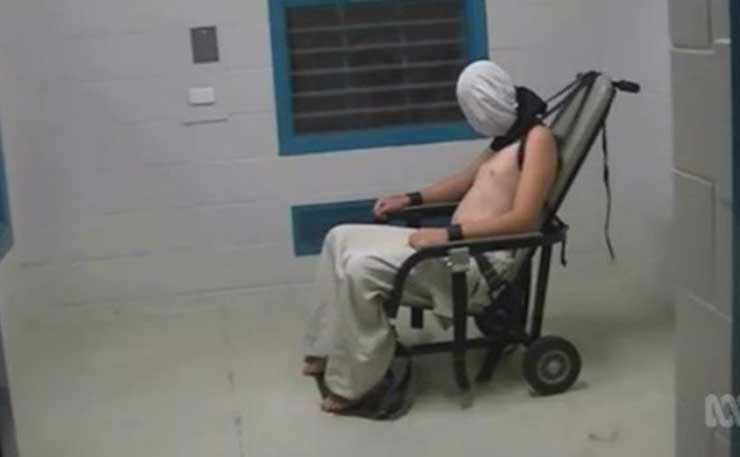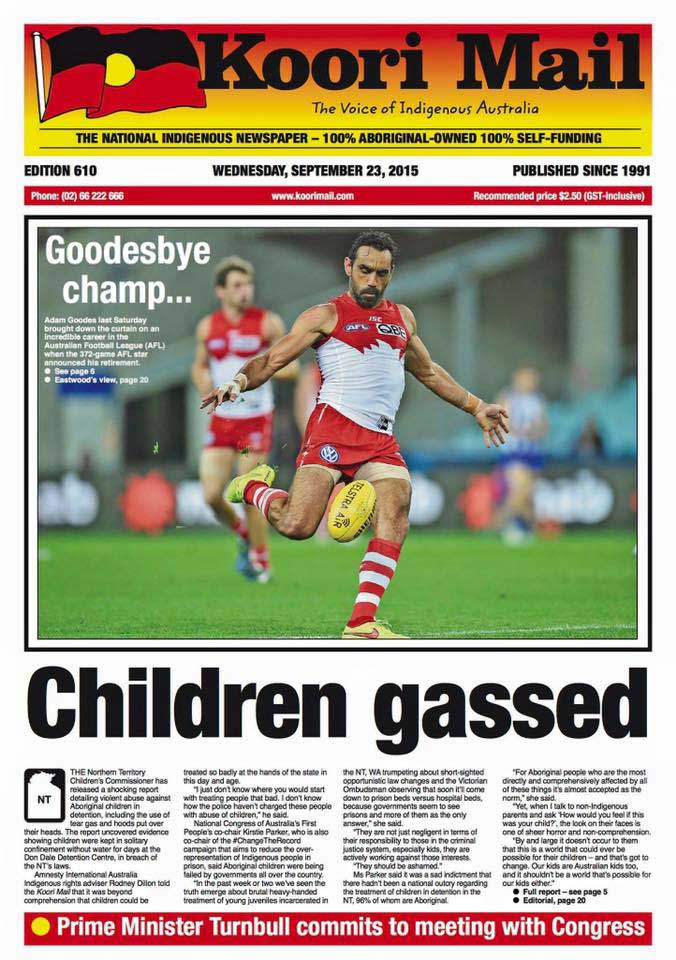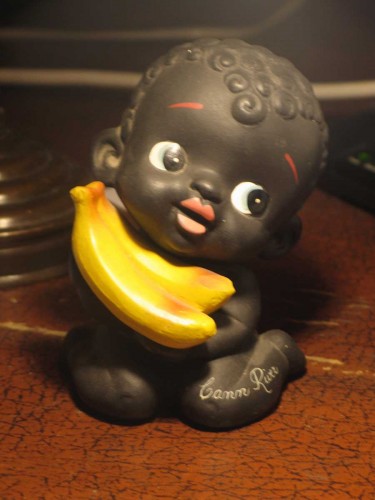A special place is reserved in settler-colonialism for Aboriginal kids. To this day, writes Liz Conor.
If Four Corners had screened CCTV footage of Dylan Voller, high on ice, bashing a teenager in a car park before his mates knocked him unconscious, it might’ve tempered widespread outrage at his abject victimisation in the NT Don Dale Youth Detention Centre near Darwin, in August 2014.
It shouldn’t. Four Corners elected to refer to Voller merely as a ‘troubled boy’. Soon after this assault, Voller had levelled the nose of his Holden Commodore at a police officer, and narrowly avoided running him down.
Instead what Four Corners exposed was the unrestrained institutional violence unleashed on this child from his incarceration at barely 11 years old. As the nauseating footage unspools, it becomes cause for wonder that he didn’t take the opportunity to mow down a member of the force that had repeatedly left him in fear for his life.
Violently angry doesn’t quite cover the response it has elicited in viewers. God only knows what vengeance lurks in the battered hearts of the boys themselves.

Voller had been subjected to punitive measures so extreme they can only have been fuelled by a sadistic need to humiliate, subjugate and bear witness to the cowering anguish we witnessed last night, as he wept into his singlet, alone in his cramped cell, before being pinned by bloated men and having his underwear cut off him with a knife.
It’s a wonder they didn’t tar and feather the child bottom they’d bared just for added mortification.
Voller’s own violent outbursts between bouts of detention in these total institutions, in which men four times their body mass arbitrarily assault terrified boys, comes to be seen within the context of his own brutalization – as difficult as that must be for the family of the boy he and his mates left for dead.
How to account then for the violence of the ‘Youth Justice Officers’ at Don Dale? What’s their issue with their charges, overwhelming Aboriginal kids?
Their brief is to ‘break the cycle of youth offending by assisting young people who are in the youth justice system’. They’re required to demonstrate (splutter):
- A genuine interest in helping young people
- A positive and energetic approach and desire to make a difference
- Strong interpersonal skills and the ability to build appropriate relationships with detainees
- High level of integrity and resilience; and ominously,
- A good level of physical fitness
The department’s process for selection is a ‘bulk recruitment’ – as it was revealed from competing boxers, turbo-machos steeped, practiced and revelling in their public displays of vicious bodily blitzing. Let’s put them in charge of troubled boys.
Nearly 30 years after the Royal Commission into Aboriginal Deaths in Custody was launched Malcolm Turnbull has announced a Royal Commission into Northern Territory juvenile detention. Social media immediately erupted last night with cries of ‘What chance can they have’, and ‘Black Kids’ Lives Matter’.

But Rudi Maxwell of the Koori Mail had reported on the gassing of the children at Don Dale on September 23rd 2015. Disturbingly, as Amy McQuire has pointed out on these pages, without video evidence of violence it seems Australians show little interest in these institutional abuses. The corrective system trades on its operations being veiled. She reports that Ms Dhu’s family requested for CCTV footage of her last horrific hours be released to the public. The coroner has refused.
The Royal Commission must attend to the escalating disproportion of Aboriginal and Torres Strait Islander youth incarcerated, often for minor offences. Despite the implementation – or not – of all 399 recommendations by all state and territory governments from the Black Deaths in Custody report, 96 per cent of juveniles presently jailed in the NT are Aboriginal.
As John B. Lawrence SC (immediate past president of the Northern Territory Bar who was interviewed, seething with annealed anger, in the Four Corners report last night) notes, in the past 10 years, the numbers of Aboriginal prisoners have increased by 70 per cent.
But the Royal Commission will also have to come to grips with the long shadow of settler-colonialism’s overwhelming indifference to Indigenous children’s suffering to fully grasp the visceral ‘powder keg’ moment that seared our eyes and turned our stomachs last night.
For when Aboriginal children are abused, tortured, incarcerated and ‘pulverized’ (as one Don Dale one officer gloated) it serves a larger purpose, that of disinheritance.
Institutional violence against Aboriginal children has historically found a number of forms of expression, from enforced labour, to sexual concubinage, to state protection boards’ programs of removal from families. Every child removed from family and country, either for ‘protection’ or incarceration was effectively made a dispossessed inheritor.
Where violence and disease hadn’t accomplished the ‘Tide of History’ that vacated pastoral lands and mining leases, the removal of children severed any claims they might come to make as rightful successors.
This overarching ‘logic of elimination’ was levelled at Aboriginal children with unmitigated zeal.
The victimization of Aboriginal children has been well documented in the work of historians. Live children were reported to be ‘pitched onto the fire’ at massacre sites. Traumatized survivors were found after such assaults on their communities’ campsites ‘in the bush, alone and apparently deserted’, and were either enslaved as laborers or concubines by settlers, or dispatched to institutions such as Normal Schools. Conditions in such institutions were often perilous.
 In just one instance a four-year-old child, Cassey was beaten to death by Marie Christensen, Matron at the Myora Mission Station in 1896 after refusing to bath in the sea.
In just one instance a four-year-old child, Cassey was beaten to death by Marie Christensen, Matron at the Myora Mission Station in 1896 after refusing to bath in the sea.
The little girl was already sick and unable to take food. She was dunked in the sea, flogged with a stick, dragged and kicked while prone on the ground. A resident testified Cassey ‘was in great pain, and gasping’. She died the next day. A postmortem indicated ‘malnutrition from extreme anemia and poverty of blood’. Yet ‘half-caste’ children like Cassey were removed in droves from their families because of alleged poverty and neglect.
As adults, Aborigines carried a store of trauma from childhood histories of violence. In 1910, Walter Roth, a Queensland ‘native’ administrator, wrote, ‘On North Keppel is still to be seen the actual camping ground where at least seven males were shot down one night in cold blood, the father of one of the surviving women (who described to me the scene as it actually took place) being butchered while his little girl was clinging round his neck.’
Children were exposed to illness and disease as their material conditions of food and shelter deteriorated and their families impoverished. In 1841, Captain Sturt reported small pox had afflicted small children on the Murray, ‘so young were some whose condition was truly distressing, that he had no doubt they had been born in a state of disease’.
Port Phillip protector William Thomas reported babies born ‘literally rotten’ from syphilis.
When Aboriginal children were orphaned, or abducted from their homelands, part of their loss and rupture was to their identities through their effective disinheritance. Always behind the terrible losses they suffered, was the demise of their status as rightful heirs.
The indifference settlers largely felt towards the suffering of children in the aftermath of the frontier was entrenched in national sentiment. It is part of the inheritance of settler identity. Indeed, settlers disavowed the manifest suffering of Aboriginal children with fetish ‘piccaninny’ figurines, garden ornaments and pictures.
This racialized child type, the Piccaninny was put to work in the colonial imagination to set down very distinct claims to land ownership, inheritance, dispossession and eradication. They smiled sweetly and surreally from settler dressers and mantles at the height of policies of child removal.
Four Corner’s report into the barbaric abuses of mostly Aboriginal children at Don Dale has swept a scathing backhand through these comforting ornaments of racialized childhood – through these entrenched habits in not facing up to what Aboriginal kids endure.
The withholding of the footage of Ms Dhu’s last hours is revealing in itself. As with the grinding, punitive deprivation in offshore refugee detention camps, their viability entirely depends on being kept under wraps. What cannot be denied is that by removing Aboriginal kids they have never been made safer, instead they have been exposed to state-sanctioned abuse in the name of their protection.
The $200,000 spent on detaining, and as it transpires torturing, each Aboriginal ‘juvenile’ must be diverted into genuine supports and proven rehabilitation programs in their communities.
These detention gulags should be emptied of the children who have been damaged within their fetid walls, then maybe strewn with comfort-piccaninny ornaments, and bulldozed to the ground.
Donate To New Matilda
New Matilda is a small, independent media outlet. We survive through reader contributions, and never losing a lawsuit. If you got something from this article, giving something back helps us to continue speaking truth to power. Every little bit counts.





